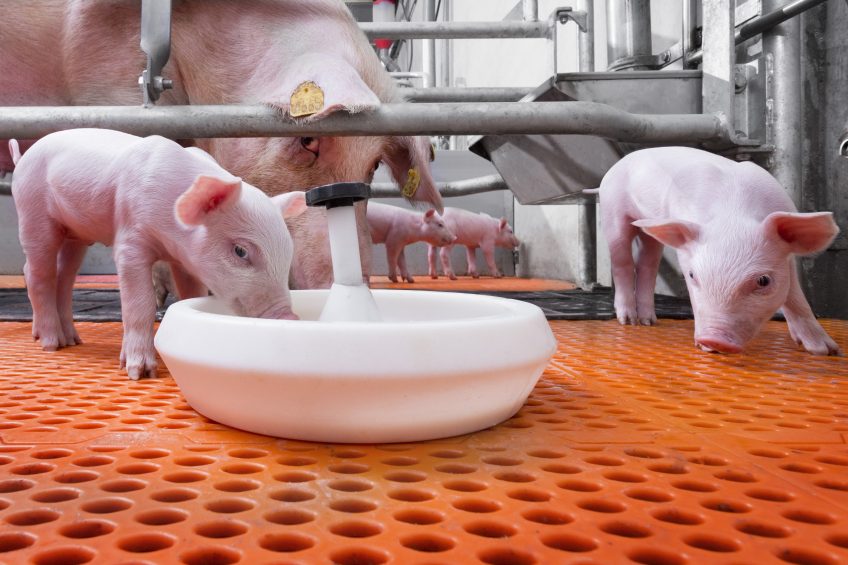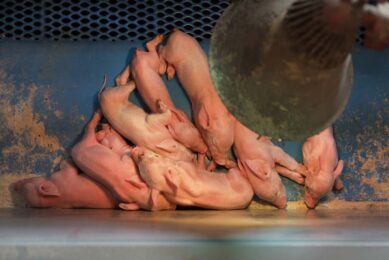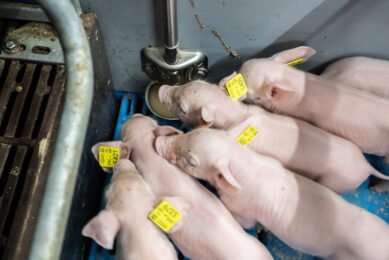Role of functional fibres in pre-weaning nutrition

One just can’t start early enough with paying close attention to piglet feed. Ingredients present in pre-weaning nutrition can be very important in preparing the animals’ guts for the vegetable diets post-weaning.
To ensure suckling piglets get a good start in life these days, there is a growing need to provide them with appropriate supplemental feeding. This is mainly due to larger litters, which are putting pressure on sows to produce more milk. As a result, a gap has arisen between the quantity of milk sows can produce and the amount of energy and protein piglets in large litters need.
This resultant trend towards supplemental feeding also reflects the now well established concept that early-life interventions can have life-long consequences, both negative (e.g. behavioural stress) and positive (e.g. a good colostrum intake and smooth weaning transition). In this paper, we show that functional fibres in diets in pre-weaning nutrition can positively alter gut health and the function of the gastro-intestinal tract (GIT).
Development of a healthy GIT
The development of a healthy GIT in early life provides the basis for a healthy and productive pig. During this period, the piglet’s intestines are very vulnerable to pathogens and digestive disturbances. A recent European survey* showed that 10% of sow farms were experiencing problems with diarrhoea in suckling piglets, and that close to half the post-mortem examinations conducted by the veterinary service indicated intestinal ailments.
Trouw Nutrition aims to further explore ways of optimising supplemental milk and/or feed to accelerate the development of the young GIT into a healthy and well-matured organ. Recent work at the company’s Swine Research Centre in the Netherlands has shown that selected fibres are important dietary constituents in this respect. In this paper, the results of one of the studies are examined.
GIT maturation in piglets
What exactly is the concept of GIT maturation? At birth, the neonatal pig’s GIT (comprising the stomach, and the small and large intestines) is rather immature. Not only is it small in size, it has also not yet fully acquired the three important functions of the adult GIT, being the digestion of feed, the uptake of nutrients into the body and the protection of the pig against pathogens and toxins (see Figure 1).
Figure 1 – Factors affecting the functional maturation of the gastro-intestinal tract (GIT).

The latter (also referred to as the ‘barrier function’) is particularly important, as the intestines represent a large surface area and a potential route by which putative pathogens or toxins can enter the body. This explains why the mature gut wall is equipped with an extensive immune system and why it has the ability to distinguish harmful from nutritive entities. In this light, it is desirable that GIT maturation takes place rapidly, ideally before weaning (see Figure 2). Although the maturation process is partly driven genetically, it also has plasticity and can potentially be accelerated through nutrition. This has already been shown in a number of classic studies* in which creep feeding aided precocious gastric function.
Figure 2 – Timeline of GIT development.

Supplemental feeding supports GIT maturation
The GIT maturation process is driven by the pig’s genetic make-up on the one hand and by external factors, such as nutrition, on the other (see Figure 1). The first drastic developmental changes in the GIT are induced by colostrum and sow’s milk. These supply, by nature, all the nutrients, growth factors, and protection the GIT needs during the early days of post-natal life. Ideally though, moving towards the moment of abrupt early weaning (days 21-28), the GIT is prepared for processing the more ‘challenging’ nutrient sources present in commercial pig diets.
It is now believed that the microbiota population of the GIT plays a pivotal role in this respect, as it responds to nutrition and interacts with the cells of the gut and the immune system. It would, therefore, seem to be appropriate to start working with dietary fibres, as they are known to directly affect the composition of the microorganisms in the GIT.

Stimulating gut growth
It was hypothesised that adding a mixture of selected fibres present in wheat bran would stimulate gut growth. Fibres were, therefore, added to the milk supplement and dry creep feeds (replacing corn starch) fed to one group, and the results were compared with a conventional low-fibre (control) group. All sows were managed in the same way, and weaning took place at 3.5 weeks.
Overall, the high-fibre treatment resulted in a numerical improvement in the intake of dry matter from supplemental feed (817g compared to 450g), while weaning weights were not significantly affected. The most striking differences, however, were found in the dimensions of the small and large intestines. For instance, in the high-fibre treatment, the small intestine tended to be 18% longer and the large intestine 25% heavier (see Table 1). Although the data on gut barrier function were not conclusive, all in all, the data are in line with a more mature gut system at weaning and it is conceivable that this will result in fewer cases of digestive upset in the post-weaning phases of production.
Pre-weaning nutrition including fibres
In summary, on the basis of data from the scientific field and from data gathered by Trouw Nutrition, it is possible to infer that pre-weaning nutrition incorporating e.g. fibres can aid gut development, which better prepares the piglets for predominantly vegetable diets post-weaning. This is in line with findings in pre-weaning calf nutrition. It may, therefore, be concluded that targeted supplemental feeding supports a good life start, which reduces health complications following weaning, thus enhancing productivity.
* References available on request.
Join 18,000+ subscribers
Subscribe to our newsletter to stay updated about all the need-to-know content in the pigsector, three times a week. Beheer
Beheer










 WP Admin
WP Admin  Bewerk bericht
Bewerk bericht